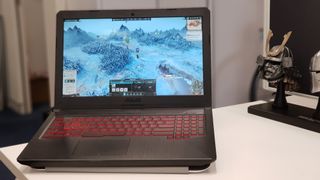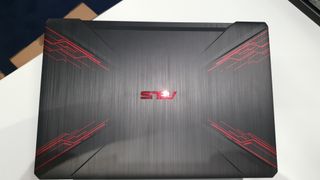Why you can trust TechRadar
Storage
The fundamental storage configuration on the TUF FX504 seems reasonably commonplace on the surface. Both devices offer a smaller SSD for the operating system and essential apps, combined with a larger-capacity platter-based hard disk drive for stashing games. Look a little closer however, and both models offer interesting storage features that are uncommon amongst the ranks of affordable gaming laptops.
The less-expensive FX504GD model features a 128GB SSD connected via PCIe for 1500MB/s read speeds. This much faster drive isn’t overly common on devices in this price bracket and so when combined with a 5400rpm 1TB HDD, you get a particularly appealing storage configuration for an entry level gaming laptop.
If we shift focus to the FX504GE you see this SSD go up in size to a 256GB capacity, but it loses out on the PCIe connection — defaulting to the SATA 3 (6Gbps) interface for read speeds of just 500MB/s. While PCIe speeds are undoubtedly desirable, both these drives max out at around 500MB/s write speeds, so it makes sense on balance for the larger-but-slower SSD to sit on the more expensive model.
What most excites us on the FX504GE however, is the addition of a new kind of SSD/HDD hybrid drive that accompanies the primary SSD. This hybrid drive bolts a mini SSD to a traditional HDD to offer the same 1TB storage capacity at significantly faster transfer rates. Seagate’s 2.5-inch Fire Cuda drive uses the mini SSD to temporarily store the most regularly used information in order to reduce the need for spinning the platter. This translates into game loads that are between 2 and 5 times faster and should, theoretically, increase the overall longevity of the hard drive by reducing mechanical wear and tear.
Screen

One thing that you could say is missing from the TUF FX504 is a fast 120Hz+ screen for more responsive and smoother gaming visuals, but considering there’s only a GTX 1050Ti GPU (at best) you don’t really have the processing power to run the majority of games fast enough to utilize such a fast screen anyway.
The 15.6-inch FHD display that’s on offer comes with either a TN or IPS panel. These two technologies will give you two distinct color profiles and viewing angles, but both apparently exceed the sRGB gamut by 130% and run at 60Hz to offer comparable game display experiences.
Performance
The engineering sample we got hands on time with only had 4GB of RAM, some 12GB shy of the on-sale configuration, so it can’t be relied on for any performance benchmarks. We did however run the CPU-specific Cinebench R15 benchmark in order to check the new Intel Core i7 chip was performing as expected. With a multi-threaded score of 752 and a single core score of 166 in a recommended power mode, it’s clear that the new chip is an improvement over Intel’s Core i7-7700HQ CPUs.
We didn’t attempt to crank out a Cinebench R15 CPU score in performance mode since the sample had only partially perforated vents and an unfinished thermal management system. Even without pushing the chip to its limits, the balanced scores put it in position to compete with the lofty 1,100-plus multi-threaded scores that were seen on the MSI’s GE63 Raider and the new Gigabyte Aero 15 using a Core i7-8750H CPU at full-tilt in a performance-mode power configuration.
Early verdict

At a little over 0.98-inches (2.5cm) thick and weighing around 5 pounds (2.3kg), this laptop isn’t as portable as something like Asus’ Vivobook Pro (which also has a GTX 1050). Put it up against something like Asus’ 5.5-pound ROG Strix GL553VE form last year and it looks relatively slim, shaving off close to 10% of the overall weight.
If you're not looking to move it around much, then there’s a lot of features on offer here that make up for the thicker form factor. We haven’t had the opportunity to vet the positive effects of the TUF FX504’s ‘Anti-Dust Cooling’ ventilation or the more resilient keyboard, but from what we can tell the SSHD on the FX504GE will make a big difference to both game load speed and longevity. In addition to these key components there are some smaller details like the vented WSAD keys and the choice of business or gaming shell coloring that emphasize the amount of thought that has gone into this device.
It’s impossible to accurately assess a laptop without first benchmarking its performance, but from what we can see, the two new TUF FX504 units seem to land at a fair price. If you aren't fissed about portability and want a gaming laptop that’ll last, then the FX504 has a number of features that you won’t find elsewhere. The only caveat is that the FX504 leans on Nvidia’s two entry level graphics cards, which don’t offer enough power to be expected to perform well on games that’ll be released in three to five years time. So even if the TUF FX504 is considerably more durable, it’s debatable as to whether it really needs to be.
- 1
- 2
Current page: Storage, screen, performance and early verdict
Prev Page Intro, price, availability and design
Joel has been the in-house benchmark monkey for the Australian TechRadar team and Australia’s two biggest tech magazines (APC and TechLife) since 2014.
What is a hands on review?
Hands on reviews' are a journalist's first impressions of a piece of kit based on spending some time with it. It may be just a few moments, or a few hours. The important thing is we have been able to play with it ourselves and can give you some sense of what it's like to use, even if it's only an embryonic view. For more information, see TechRadar's Reviews Guarantee.

